Rising STD Rates in America
An Emerging Healthcare Crisis

Americans today are having less sex than they used to 15 years ago.1 Despite this, the rates of Sexually Transmitted Diseases (STDs) in the U.S. have continued to rapidly climb, since 2013.
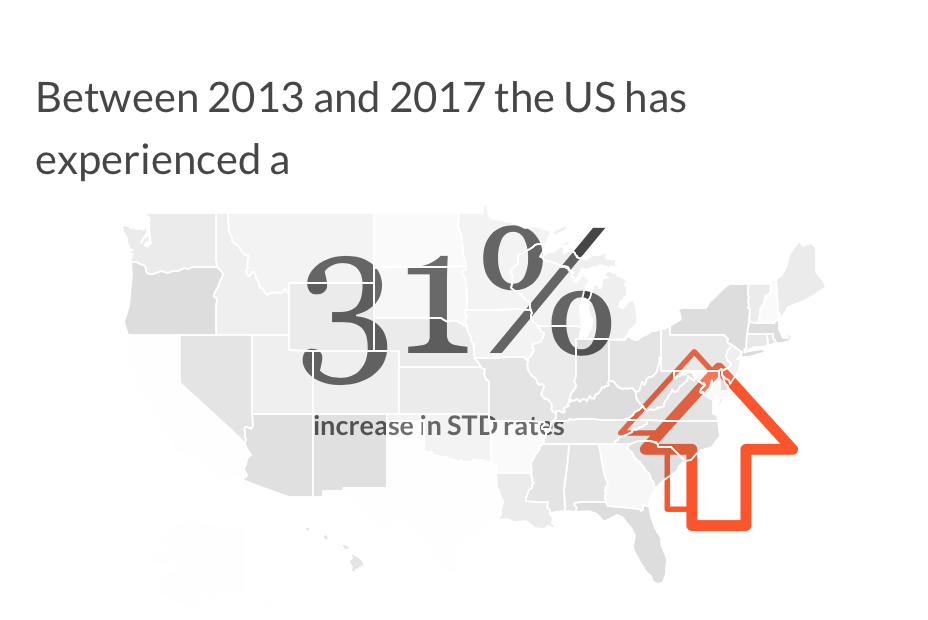
Source: Centers for Disease Control and Prevention
In 2017, 2.3 million cases of Chlamydia, Gonorrhea and Syphilis were diagnosed, surpassing 2016's record by more than 200,000.2
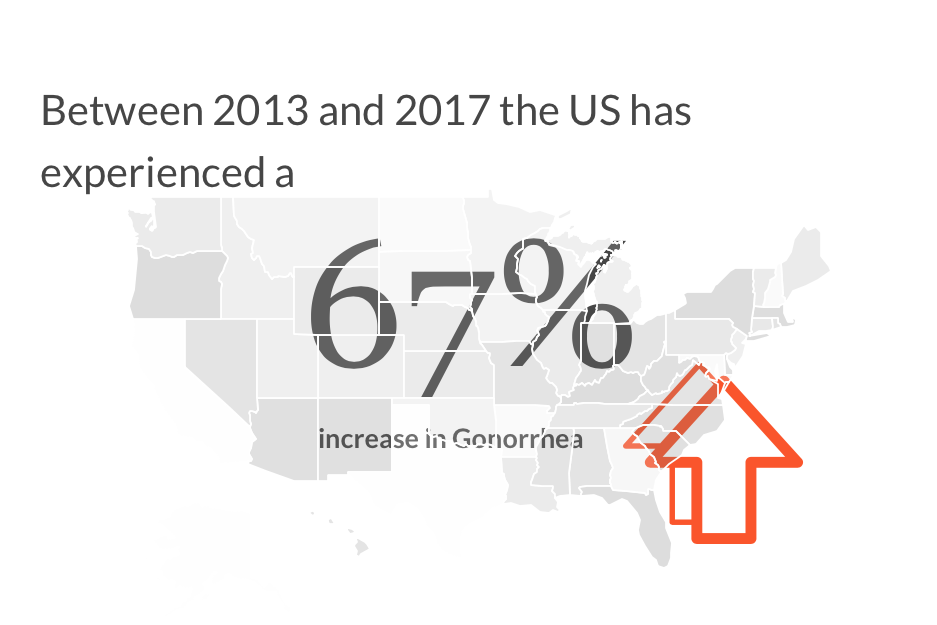
Source: Centers for Disease Control and Prevention
Note, that STD prevalence for all three diseases in the above chart has been steadily rising between 2013 and 2017. This is all the more alarming when we consider that many cases, in fact, go undiagnosed and untreated.3 The consequences of untreated infections can include infertility, ectopic pregnancy, stillbirth in infants, and increased HIV risk.
However, STDs don't just have repercussions for individual health; they are also a drain for national resources. The Center for Disease Control and Prevention (CDC) reports that the United States spends about $16 billion each year treating STDs.4
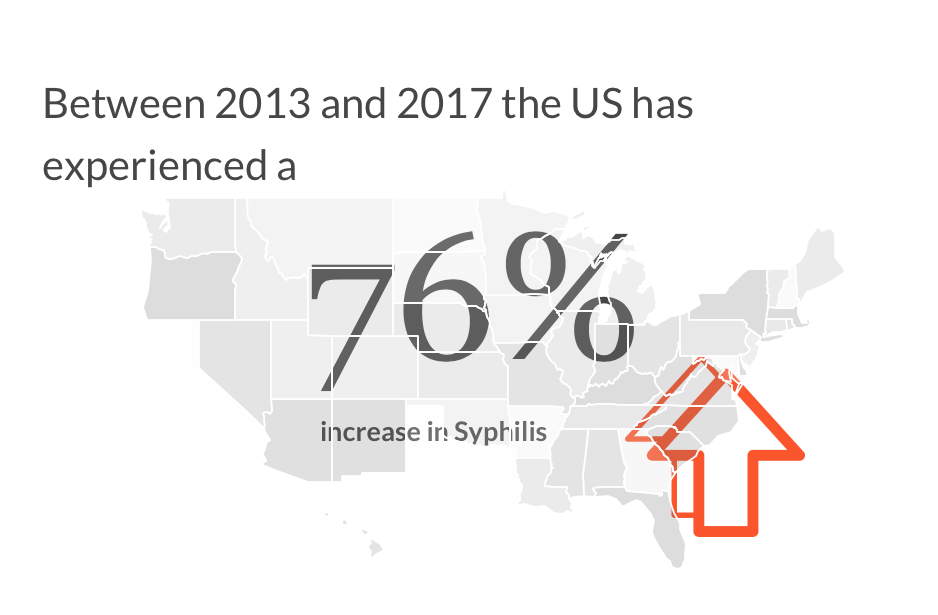
Source: Centers for Disease Control and Prevention
It is, therefore, imperative to find methods to respond to this emerging healthcare crisis. But before, an appropriate response can be formulated, it is important to identify populations at risk.
Below, we take a closer look at the rise in prevalence of Chlamydia, Gonorrhea and Syphilis in the United States, before exploring the potential reasons for this increase. We conclude by offering actionable responses to this growing concern.
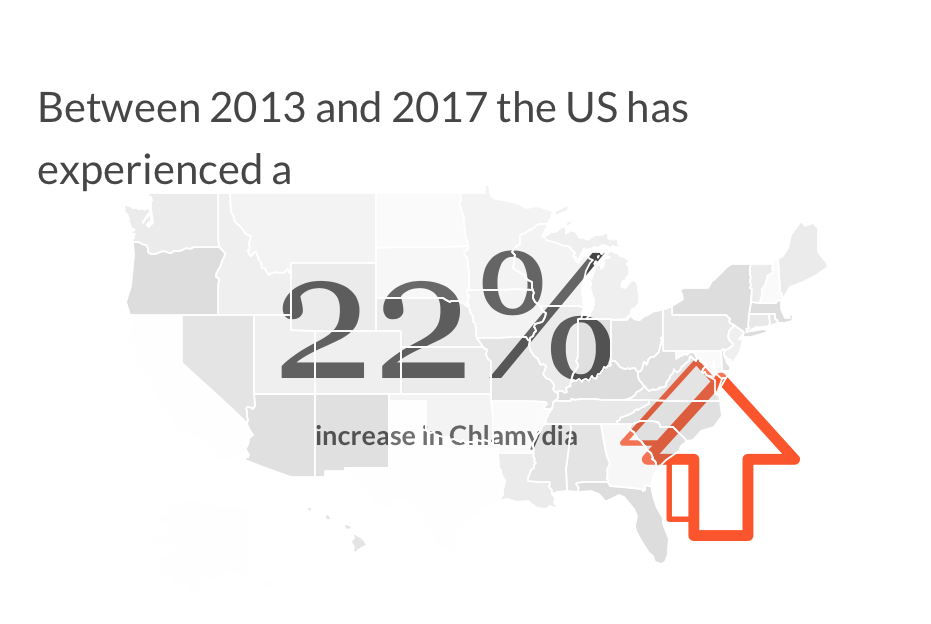
Source: Centers for Disease Control and Prevention

Source: Centers for Disease Control and Prevention
Source: Centers for Disease Control and Prevention

Source: Centers for Disease Control and Prevention
Source: Centers for Disease Control and Prevention

Source: Centers for Disease Control and Prevention
Source: Centers for Disease Control and Prevention

Source: Centers for Disease Control and Prevention
Source: Centers for Disease Control and Prevention
Chlamydia
Passed on through sexual intercourse without using a condom
Treatable with Antibiotics.

Chlamydia is the most common notifiable disease in the United States. Since 1994, it has comprised the largest proportion of all STDs reported to the CDC.5
Between 2013 and 2017, Chlamydia cases have continued to rise across the United States.
The reported cases of Chlamydia were highest in the South for the year 2017, but between 2013 and 2017, the largest rate of increase occurred in the West.6
Although rates of reported cases among men are generally lower than rates among women, rates among men increased almost 40% between 2013 and 2017. This may be the result of a higher number of men, including gay and bisexual men, being tested and diagnosed with Chlamydia due to the increased availability of urine testing, and extra-genital screening.7
Rates of reported chlamydia are the highest among adolescent and young adults, across both sexes. In 2017, almost 70% of all reported chlamydia cases were among persons aged between 15 and 24 years.8
Toggle between the charts for males and females, to see how Chlamydia prevalence varies across age groups.
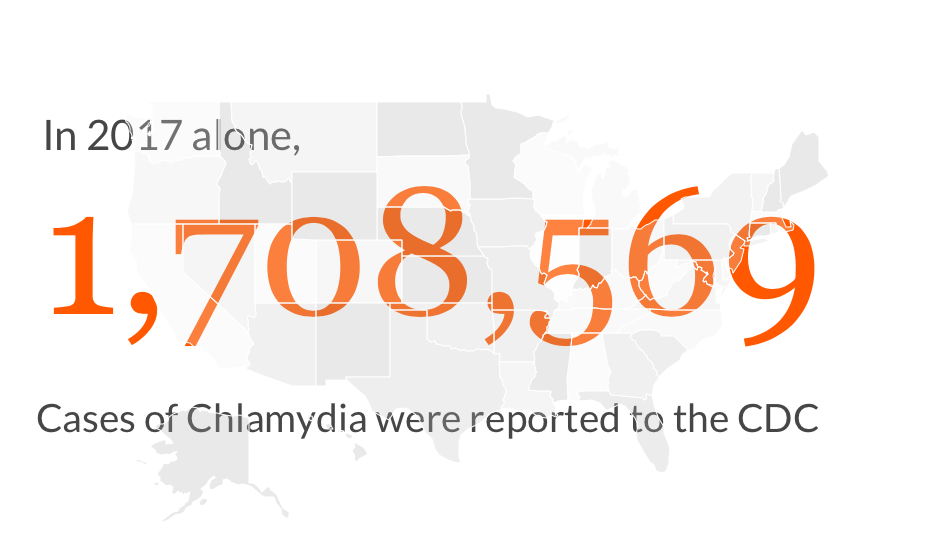
Source: Centers of Disease Control and Prevention
Source: Centers of Disease Control and Prevention
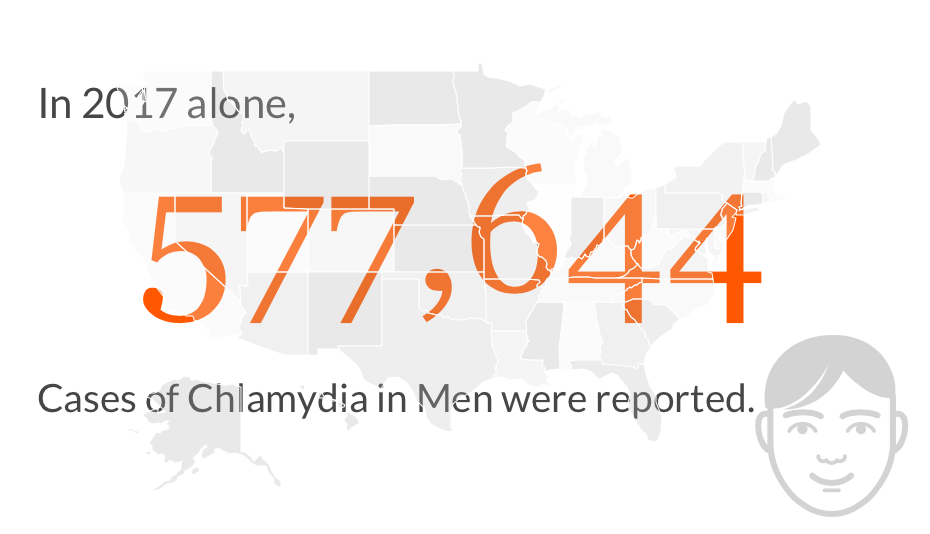
Source: Centers of Disease Control and Prevention
Source: Centers of Disease Control and Prevention
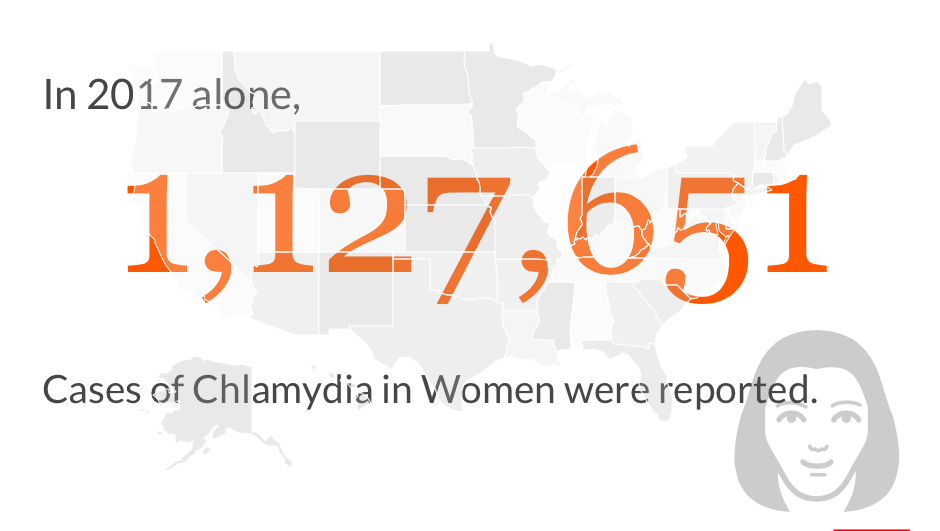
Source: Centers of Disease Control and Prevention
Source: Centers of Disease Control and Prevention
Gonorrhea
Commonly spread through unprotected sex. May cause no symptoms.
Treatable with Antibiotics.

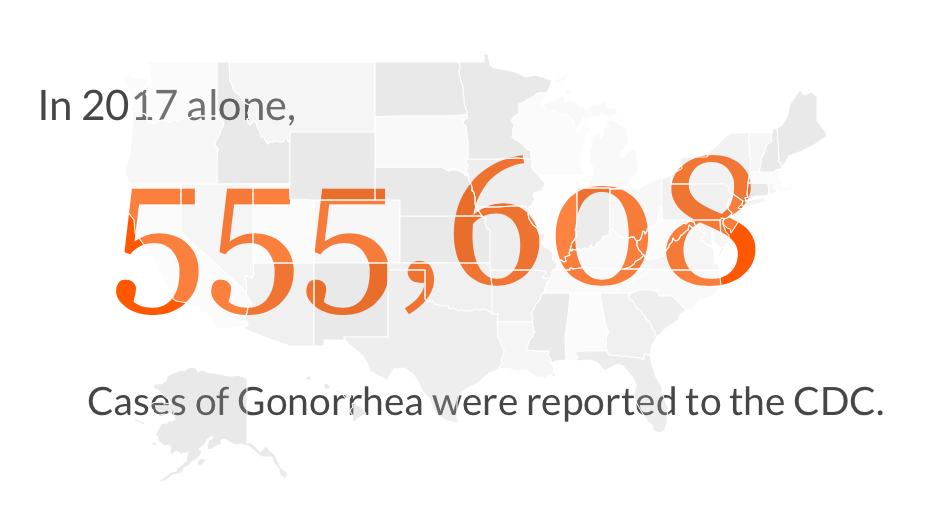
Source: Centers for Disease Control and Prevention
Gonorrhea is the second most notifiable condition in the United States.9 Rates of reported gonorrhea have increased 75.2%, since they reached historic lows in 2009.10
Between 2013 and 2017, Gonorrhea cases have continued to rise across the United States.
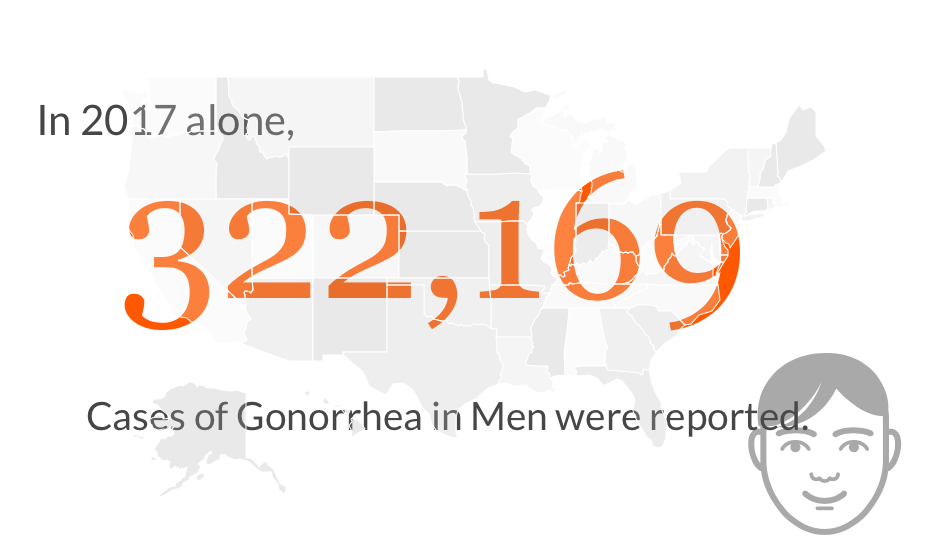
Source: Centers for Disease Control and Prevention
The reported cases of Gonorrhea were the highest in the South for the year 2017, but between 2013 and 2017, the largest rates of increase occurred in the West and the Midwest.11
Gonorrhea prevalence, in 2017, was higher amongst males than females. From 2016 to 2017, cases of Gonorrhea grew by 19.3% for males and 17.8% for females. The magnitude of the increase among males could be the result of either increased transmission or increased screening.12
Additionally, individuals aged between15 and 44 years accounted for 91.8% of cases of Gonorrhea reported. For individuals aged between 15 and 19 years, rates increased 15.5% from 2016 to 2017.13
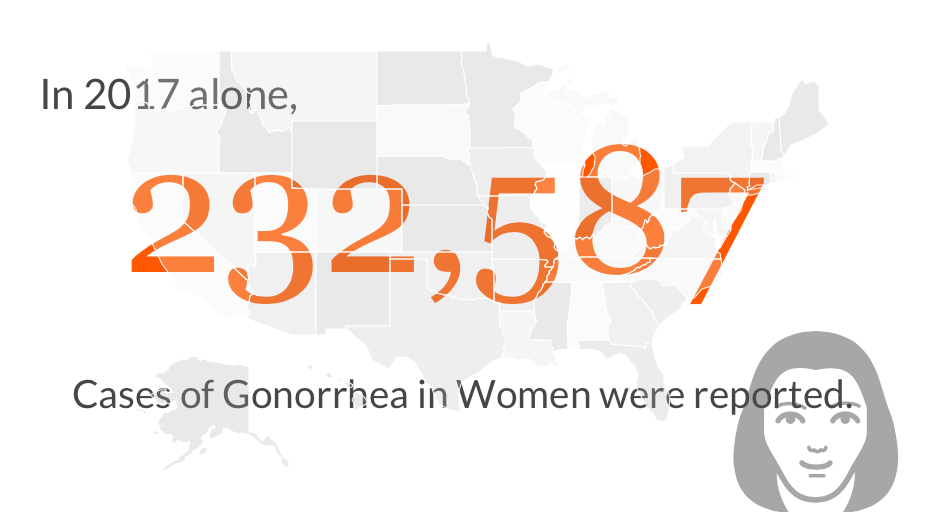
Source: Centers for Disease Control and Prevention
Toggle between the charts for males and females, to see how Gonorrhea prevalence varies across age groups. Notice that older men are more likely to be affected by Gonorrhea, in comparison to older women.

Source: Centers for Disease Control and Prevention
Source: Centers for Disease Control and Prevention

Source: Centers for Disease Control and Prevention
Source: Centers for Disease Control and Prevention

Source: Centers for Disease Control and Prevention
Source: Centers for Disease Control and Prevention
Syphilis
Spread through skin-to-skin contact with an infected individual. Causes sores on skin.
Treatable with antibiotics.

Syphilis can occur in four stages: Primary, Secondary, Latent, and Tertiary. Since reaching a historic low in the early 2000s, cases of almost all stages of Syphilis have increased in subsequent years.14
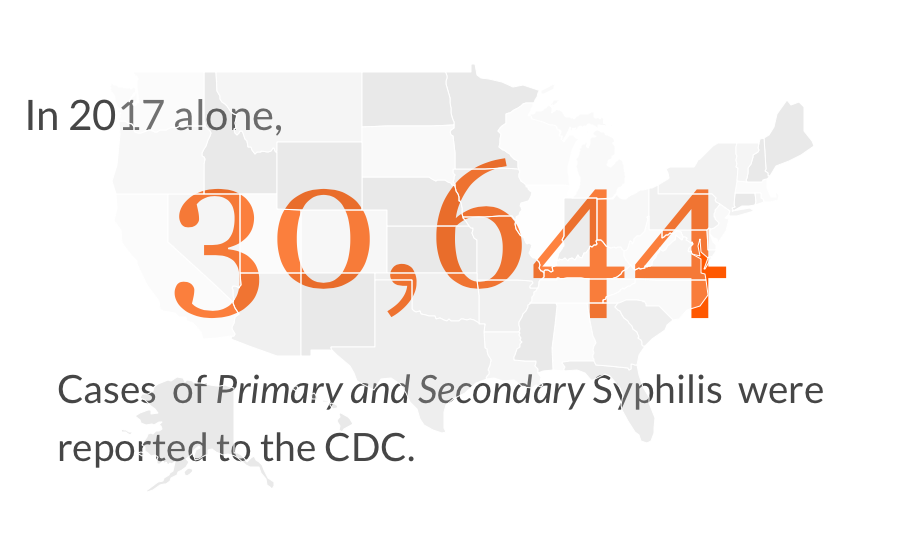
Source: Centers for Disease Control and Prevention
Geographically, the most cases of all stages of Syphilis are reported in the South. However, the most cases of Primary and Secondary Syphilis are reported in the West.
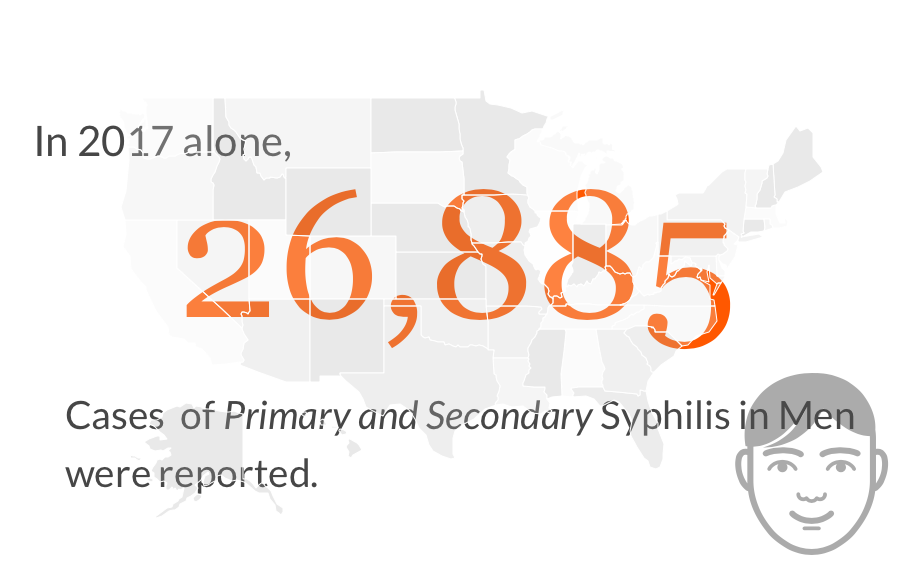
Source: Centers for Disease Control and Prevention
This is striking because of all stages, the primary and secondary are most infectious. Between 2016 and 2017, cases of Primary and Secondary Syphilis grew by almost 10.5% across the United States. Prevalence of these stages of Syphilis is much higher in men than women.15
In 2017, the highest numbers of Primary and Secondary Syphilis were reported among individuals aged between 25 and 29 years. From 2016 to 2017, the overall rate of reported Primary and Secondary Syphilis cases increased in all age groups 15 years and older. 16
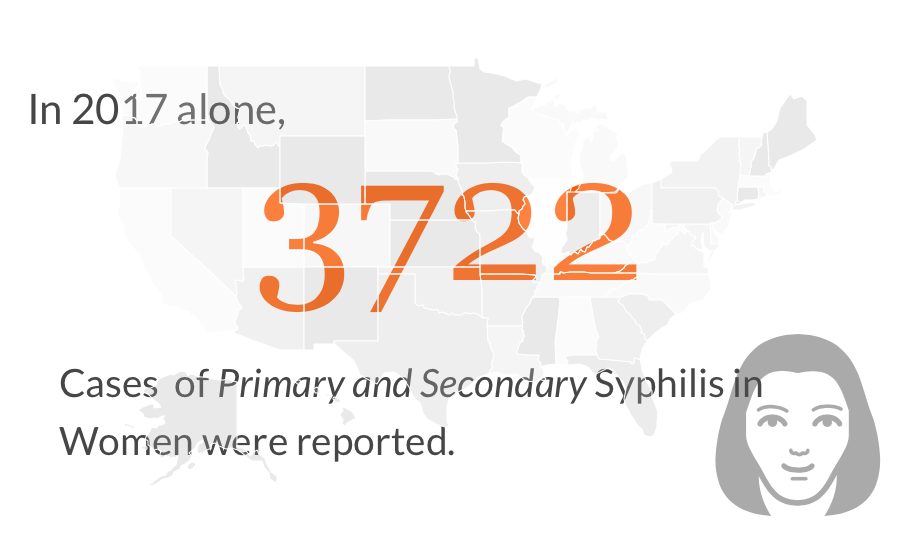
Source: Centers for Disease Control and Prevention
Toggle between the charts for males and females, to see how Primary and Secondary Stage Syphilis prevalence varies across age groups.

Source: Centers for Disease Control and Prevention
Source: Centers for Disease Control and Prevention

Source: Centers for Disease Control and Prevention
Source: Centers for Disease Control and Prevention

Source: Centers for Disease Control and Prevention
Source: Centers for Disease Control and Prevention
Why are STD Rates Rising?

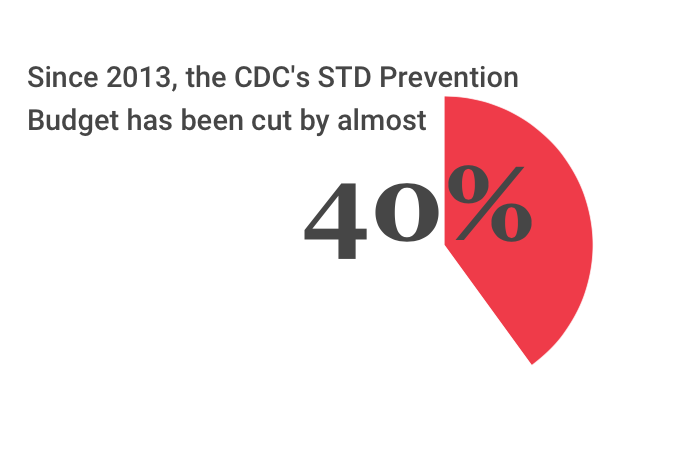
Source: CNN
Source: CNN
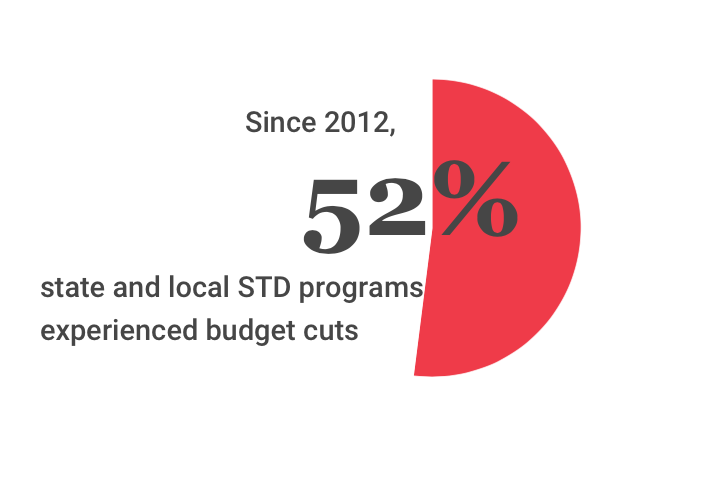
Source: Centers for Disease Control and Prevention
Source: Centers for Disease Control and Prevention
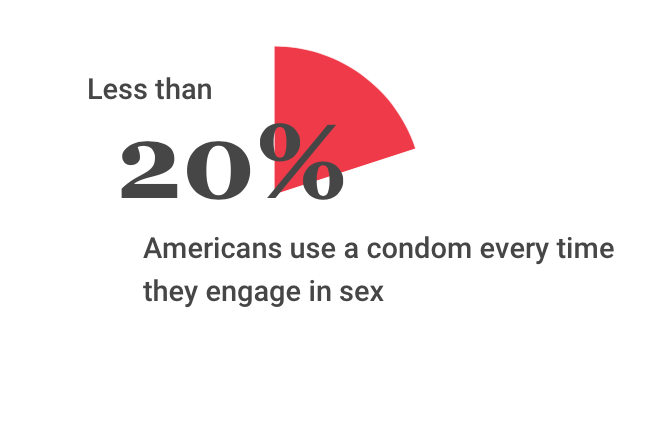
Source: Time
Source: Time
The recent growth in STD rates can be attributed to three reasons:
- A decline in the budget available to federal resources like the CDC
- The shutdown of a large number of publicly funded STD clinics
- The rising rates of Americans engaging in riskier sexual activity.17,18

Source: CNN
Since 2003, the CDC's STD prevention budget has been cut by almost 40%. This reduces the CDC's ability to launch targeted public health awareness campaigns, make treatment resources more accessible, and to fund research STD prevention and treatment.20

Source: Centers for Disease Control and Prevention
In addition, following 2012, the Affordable Care Act created the perception that since each individual would have a "medical home", publicly funded clinics were no longer a necessity.21 This resulted in "52% of state and local STD programs" experiencing budget cuts. In 2012 alone, 21 local health department STD clinics were shut down.22 This contributed to a decline in clinic hours, screening, and contact tracing for partners of STD infected individuals.23

Source: Time
Lastly, while young adults in America are now engaging in less sexual activity with fewer partners, riskier sexual behaviour in other age groups and particular communities has actually increased.24 A report from the National Centre for Health Statistics shows that less than 20% of Americans use a condom every time they engage in sex, and that the rate of condom use declines with age.25 While condom use amongst communities of men who have sex with men has been declining for several years, condom-less sex has also been increasing in heterosexual individuals, especially women.26
What Can You Do?
Prevention and Screening

Since many STDs do not exhibit visible symptoms, individuals remain unaware of when a disease has been contracted, or when it is passed on.27
Many communities also do not realize that they are a community with a high STD incidence rate. As a result, they do not take any preventative or curative measures to protect themselves.
Lastly, many individuals forego condoms if they are using alternative forms of protection. This makes them vulnerable to transmission.
In light of this, the CDC recommends that:
- Individuals use condoms every time they engage in sexual activity
- All sexually active individuals get screened for STDs annually, particularly women under 25, and men engaging in sex with other men.28 Find resources on where to get tested here
- Individuals who test positive, ask their partners to get tested and begin treatment immediately
Most STDs are curable and treatable. Engaging in safe sex, and expanding screening can not only help you be healthier, but help your community be healthier too.
This visual essay was created for a course in Telling Stories with Data course taught by Professor Chris Goranson, at Carnegie Mellon University's Heinz College.
All data for this project comes from the Centers for Disease Control and Prevention's 2017 Report on STD Surveillance.
References
1 Matthew Haag, "It's not Just You. Americans Are Having Less Sex", The New York Times, March 8, 2017. Accessed February 25, 2019. https://www.nytimes.com/2017/03/08/us/americans-less-sex-study.html
2 "Sexually Transmitted Disease Surveillance 2017", Centers for Disease Control and Prevention. Accessed February 25, 2019. https://www.cdc.gov/std/stats17/2017-STD-Surveillance-Report_CDC-clearance-9.10.18.pdf
3 "New CDC Data Show that STD Rates Continue to Rise", American Sexual Health Association. August 29, 2018. Accessed February 25, 2019. http://www.ashasexualhealth.org/cdc-data-shows-std-rates-continue-rise/
4 "2016 Sexually Transmitted Diseases Surveillance", Centers for Disease Control and Prevention, Accessed December 11, 2018. https://www.cdc.gov/std/stats16/foreword.htm
5 "Sexually Transmitted Disease Surveillance 2017", Centers for Disease Control and Prevention. Accessed February 25, 2019. https://www.cdc.gov/std/stats17/2017-STD-Surveillance-Report_CDC-clearance-9.10.18.pdf
6 Ibid.
7 Ibid.
8 Ibid.
9 Ibid.
10 Ibid.
11 Ibid.
12 Ibid.
13 Ibid.
14 Ibid.
15 Ibid.
16 Ibid.
17 Jamie Ducharme, "Why STD Rates Are Higher Than They've Ever Been", Time, August 29, 2018. Accessed December 11, 2018. http://time.com/5381625/std-rates-funding/
18 Ashley Fetters, "Why are STDs on the Rise if Americans are Having Less Sex", The Atlantic, August 29, 2018. Accessed October 25, 2018. https://www.theatlantic.com/family/archive/2018/08/why-are-stds-on-the-rise-if-people-are-having-less-sex/568909/
19 Jacqueline Howard, " Rates of three STDS reach record high, CDC says", CNN, August 28, 2018. Accessed October 25, 2018. https://www.cnn.com/2018/08/28/health/std-rates-united-states-2018-bn/index.html
20 Jamie Ducharme, "Why STD Rates Are Higher Than They've Ever Been", Time, August 29, 2018. Accessed December 11, 2018. http://time.com/5381625/std-rates-funding/
21 Ibid.
22 "2016 Sexually Trasmitted Diseases Surveillance", Centres for Disease Control and Prevention, Accessed December 11, 2018. https://www.cdc.gov/std/stats16/foreword.htm
23 Ibid.
24 Ashley Fetters, "Why are STDs on the Rise if Americans are Having Less Sex", The Atlantic, August 29, 2018. Accessed October 25, 2018. https://www.theatlantic.com/family/archive/2018/08/why-are-stds-on-the-rise-if-people-are-having-less-sex/568909/
25 Alexandria Sifferlin, "14% More Men Are Using Condoms: Study", Time, August 10, 2017, Accessed December 11, 2018. http://time.com/4893605/latex-condom-birth-control/
26 Ashley Fetters, "Why are STDs on the Rise if Americans are Having Less Sex", The Atlantic, August 29, 2018. Accessed October 25, 2018. https://www.theatlantic.com/family/archive/2018/08/why-are-stds-on-the-rise-if-people-are-having-less-sex/568909/
27 Richard Harris, "Record High Number of STD Infections in US, As Prevention Funding Declines", NPR, August 28, 2018, Accessed December 11, 2018. https://www.npr.org/sections/health-shots/2018/08/28/642664883/record-high-number-of-std-infections-in-u-s-as-prevention-funding-declines
28 "New CDC Data Show that STD Rates Continue to Rise", American Sexual Health Association. August 29, 2018. Accessed February 25, 2019. http://www.ashasexualhealth.org/cdc-data-shows-std-rates-continue-rise/




